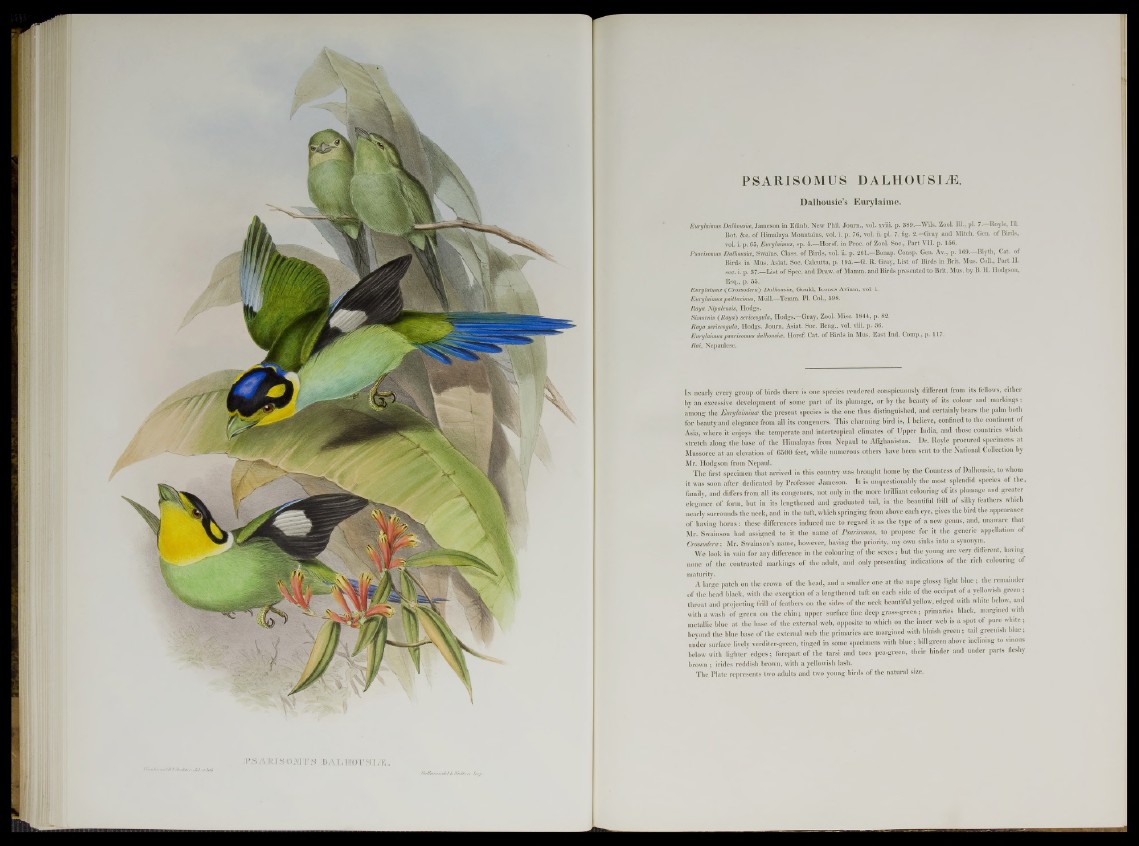
PSARISOMUS DALHOUSI iE.
Dalhousie’s Eurylaime.
Eurylaimus D oUiousub, Jameson in Edinb. New Phil. Journ., vol. xviii. p. 389.—Wils. Zool. III., pi. 7. Royle, 111.
Bot. &c. of Himalaya Mountains, vol. i. p. 76, vol. ii. pi. 7. fig. 2.—Gray and Mitch. Gen. of Birds,
vol. i. p. 65, Eurylaimus, sp. 5.-—Horsf. in Proc. of Zool. Soc., Part V II. p. 156.
Psarisomus Dalhousue, Swains. Class, of Birds, vol. ii. p. 261.—Bonap. Consp. Gen. Av., p. 169.—Blyth, Cat. of
Birds in Mus. Asiat. Soc. Calcutta, p. 195.—G. R. Gray, List of Birds in Brit. Mus. Coll., Part II.
sec. i. p. 37.—List of Spec, and Draw, of Mamm. and Birds presented to Brit. Mus. by B. H. Hodgson,
Esq., p. 55.
Eurylaimus (Crossodera) DalhousuB, Gould, leones Avium, vol. i.
Eurylaimus psittacinus, Mull.—Temm. PI. Col., 598.
Raya Nipalensis, Hodgs.
Simomis (Raya) sericeogula, Hodgs.—Gray, Zool. Misc. 1844, p. 82.
Raya sericeogula, Hodgs. Journ. Asiat. Soc. Beng., vol. viii. p. 36.
Eurylaimus psarisomus dalhousiee, Horsf. Cat. of Birds in Mus. East Ind. Comp., p. 117.
Rai, Nepaulese.
In nearly every group of birds there is one species rendered conspicuously different from its fellows, either
by an excessive development of some part of its plumage, or by the beauty of its colour and markings:
among the Eurylaimince the present species is the one thus distinguished, and certainly bears the palm both
for beauty and elegance from all its congeners. This charming bird is, I believe, confined to the contiuent of
Asia, where it enjoys the temperate and intertropical climates of Upper India, and those countries which
stretch along the base of the Himalayas from Nepaul to Affghanistan. Dr. Royle procured specimens at
Mussoree at an elevation of 6500 feet, while numerous others have been sent to the National Collection by
Mr. Hodgson from Nepaul.
The first specimen that arrived in this country was brought home by the Countess of Dalhousie, to whom
it was soon after dedicated by Professor Jameson. It is unquestionably the most splendid species of the.
family, and differs from all its congeners, not only in the more brilliant colouring of its plumage and greater
elegance of form, but in its lengthened and graduated tail, in the beautiful frill of silky feathers which
nearly surrounds the neck, and in the tuft, which springing from above each eye, gives the bird the appearance
of having horns: these differences induced me to regard it as the type of a new genus, and, unaware that
Mr. Swainson had assigned to it the name of Psarisomus, to propose for it the generic appellation of
Crossodera: Mr. Swainson’s name, however, having the priority, my own sinks into a synonym.
We look in vain for any difference in the colouring of the sexes; but the young are very different, having
none of the contrasted markings of the adult, and only presenting indications of the rich colouring of
maturity.
A large patch on the crown of the head, and a smaller one at the nape glossy light blue; the remainder
of the head black, with the exception of a lengthened tuft on each side of the occiput of a yellowish green ;
throat and projecting frill of feathers on the sides of the neck beautiful yellow, edged with white below, and
with a wash of green on the chin; upper surface fine deep grass-green; primaries black, margined with
metallic blue at the base of the external web, opposite to which on the inner web is a spot of pure white;
beyond the blue base of the external web the primaries are margined with bluish green; tail greenish blue;
under surface lively verditer-green, tinged in some specimens with blue; bill green above inclining to vinous
below with lighter edges; forepart of the tarsi and toes pea-green, their hinder and under parts fleshy
brown ; irides reddish brown, with a yellowish lash.
The Plate represents two adults and two young birds of the natural size.